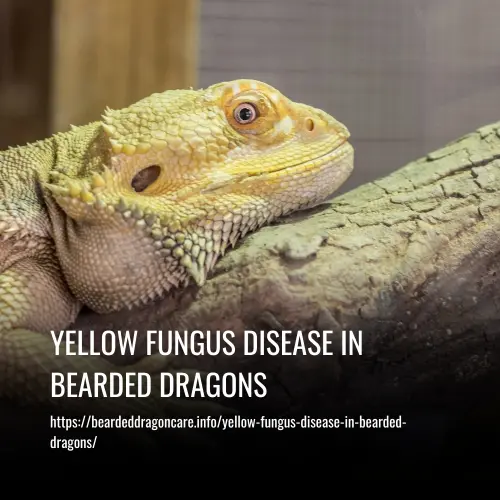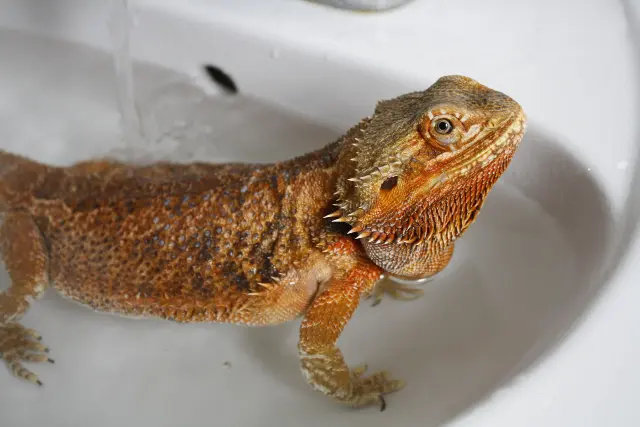Yellow Fungus Disease in Bearded Dragons
This post contains affiliate links. As an Amazon Associate, we earn from qualifying purchases.
Bearded dragons are one of the most popular pets in the world, but many pet owners don’t realize that bearded dragons can get sick, just like any other animal. One type of illness that can affect bearded dragons is yellow fungus disease.
Yellow fungus disease (YFD) is a fungal infection that affects the skin, nails, and eyes of bearded dragons. It can cause ulceration, discoloration, swollen eyelids, and difficulty breathing in infected reptiles. If it’s left untreated, your pet could become very ill.
In this article, we’ll look at the causes and potential treatments for yellow fungus disease in bearded dragons. We’ll also discuss ways to prevent it from occurring in the first place.

What is Yellow Fungus in Bearded Dragons?
Yellow fungus disease in Bearded dragons is an aggressive, fungal infection that affects the outer and deeper skin layers. If not treated early, Yellow fungus can be deadly to Bearded dragons.
Yellow fungus disease is caused by skin-eating fungus called Nanniziopsis vriesii. Although much information is lacking, it is known that this fungus has more than one form and that the Chrysosporium anamorph of N. vriesii as (aka CANV) has been identified on infected skins of Bearded dragons and other reptiles. When present, the fungus is found on the outer and deeper layers of the skin. Nanniziopsis vriesii is usually an aggressive grower and can quickly start to penetrate and eat tissues under the skin too.
Although Yellow fungus is aggressive in nature, skin lesions often only become visible some time (weeks to months) after the infection started. Poor hygiene, incorrect husbandry, and other stress factors are often the reason for instigating the disease.
What are some of the Signs and Symptoms of Yellow Fungus infection?
If you own a reptile, particularly a bearded dragon, it is important to keep an eye out for any signs or symptoms of Yellow Fungus infection. This disease can cause severe health problems and even death, so being able to spot it early is key.
Common symptoms of Yellow Fungus include weight loss, lethargy, loss of appetite, irregular breathing, and discolored patches on the skin. If you notice any of these symptoms in your pet’s health and behavior, it’s important to take them to a reptile veterinarian immediately.
Time is essential when dealing with Yellow Fungus– the sooner you can catch it and start treatment, the better their chances are of making a full recovery.
Discolored Scales
If you’re a dragon keeper, then you’ll want to be mindful of the signs and symptoms of a yellow fungus infection. These typically begin by discoloring the scales of your dragon; they will appear yellow or any other combination of colors such as brownish or greyish. It usually starts in one spot and then spreads across the body.
Furthermore, their scales may become crusty or darken over time. If you notice any of these signs, it’s best to contact a veterinarian who can provide appropriate treatment as soon as possible. By doing this, you can protect your dragon from more serious health issues later on down the line
Irregular Shedding
If you’re seeing signs of irregular shedding with your bearded dragon, it might be due to a Yellow Fungus infection. So what are some of the typical signs and symptoms? Well, the most common one is that the shedding scales look dull and brownish or greyish in color, as well as rough to the touch.
Another sign of a potential Yellow Fungus infection is when your bearded dragon sheds its skin more often than usual but doesn’t seem to be growing in size. Also, see how should your Bearded dragon shed for more information.
Random Troubling Wounds
If your pet dragon has developed a random cut or wound on its body covered with discolored and dull-looking scales, it may be suffering from Yellow Fungus.
To be sure, keep an eye out for the following signs and symptoms of this infection: swelling, redness, blistering, or pus oozing from the area; fever or listlessness; foul odor around the wound; loss of appetite; and difficulty moving the affected limb.
If you observe any of these symptoms in your pet, seek medical attention immediately to help your pet recover quickly.
How do Bearded dragons get Yellow fungus disease?
Because Yellow fungus disease in Bearded dragons can take a long time (weeks to months) to develop, the cause or origin of infection is often unknown. Yellow fungus organisms are often identified in conditions where there are:
- incorrect ultra violet (UV) exposure
- poor hygiene
- poor husbandry conditions
- overcrowding
The fungus itself can also be transmitted from one Bearded dragon to another. If a non-infected Bearded dragon comes in direct contact with an infected one, the Yellow fungus can be easily transmitted. Yellow fungus infection can also spread indirectly through either direct contact with cage furniture that was previously used by an infected Bearded dragon or being handled by a person that handled an infected Bearded dragon.
Yellow fungus disease can be introduced to non-infected Bearded dragons if proper quarantine measures have not been applied. Also, see Bearded dragon quarantine for more information.
Treating Yellow fungus disease in Bearded dragons
Yellow Fungus can be a scary and dangerous condition for bearded dragons, so it’s important to take steps to prevent it. Luckily, there are some precautionary measures you can take to minimize the risk of your beardie getting this fungus.
Practice Good Husbandry
One way to prevent yellow fungus in Bearded Dragons is to practice good husbandry. This means, first and foremost, keeping their tank clean. This involves washing and disinfecting their entire habitat at least once a day with a sanitizer.
Additionally, make sure to take apart any decorations and thoroughly clean them, as well as discard or disinfect the substrate and spray the walls down.
Finally, make sure your dragon is getting enough UVB light – this helps prevent fungal infection by boosting their overall health.
You can easily protect your bearded dragon from yellow fungus with only a few simple steps.
Keep Your Dragon Clean
One way to do this is by making sure you keep your dragon clean. The debate over whether to bathe a bearded dragon continues, as some people argue that it is not necessary, while others believe regular baths keep them safe and hydrated. Ultimately, you must decide which path to take for yourself.
If you choose to bathe your bearded dragon, make sure you’re only doing so once a week – unless they’re shedding, in which case baths can be more frequent.
Use lukewarm water and some soft baby soap, ensuring the water never reaches the shoulders of your dragon. When it comes time for bathtime, never forget to stay within the 20 minute limit and supervise at all times!

Separate Your Bearded Dragons
First and foremost, keep your Bearded Dragons separated – even if they’re from the same clutch or have become friends as babies. Only female dragons of equal size can be housed together safely. A male dragon should never be housed with another because they are prone to competition and trying to mate all the time – something that can be fatal.
Also, always limit interaction between your dragons as much as possible since solitary creatures such as bearded dragons prefer staying alone rather than being in the company of others. Keep them in separate enclosures and try not to house younglings together, since they often play-bite which increases the chance of getting injured and exposed to Yellow fungi.
Disinfect Your Everything
When it comes to caring for bearded dragons, one of the biggest challenges is preventing Yellow fungi. This is a fungal infection that can be fatal if left untreated, so it’s important to do everything we can to avoid it.
One way to do this is by carefully disinfecting any new items that are added to your dragon’s habitat, such as hammocks or rocks.
It may seem tedious, but taking the time to thoroughly clean and disinfect these items can help protect your bearded dragon from dangerous infections and diseases. Make sure you use a disinfectant specifically designed for reptiles, such as chlorine bleach diluted with water, and rinse off any excess residue afterwards.
This is especially important if you’re buying items from stores that may not take proper care in cleaning their products.
Take Them to a Reptile Vet ASAP
Preventing Yellow Fungus in Bearded Dragons is possible with a few precautions! The best way to prevent this nasty condition from affecting your dragon is by thoroughly cleaning its habitat and providing them with a healthy diet.
It’s also important to make sure you provide them with plenty of safe UVB light exposure and the necessary humidity it requires. Additionally, you should always monitor their general health, which includes regularly checking their scales for any type of discoloration or disease-like symptoms.
Finally, if there is even a suspicion that your dragon may be infected with Yellow Fungus, be sure to take them to a reptile vet immediately! Once there, they will use tests such as scanning the affected area to see if it’s a fungus and can then provide medication like Voriconazole or another antifungal agent to help destroy the fungus.
Though this medication does have high yeast levels, you should make sure your dragon gets plenty of vitamins and water in order to keep their organs healthy.
Is it safe to use an Antifungal Cream for My Bearded Dragon?
Antifungal creams have been successful at treating skin disorders in bearded dragons. To apply the cream safely, make sure your bearded dragon is fully dry first before applying the cream to the affected area twice daily. If they recently had a soak, it’s best to towel dry them before applying the cream.
Although antifungal creams are generally safe to use on your bearded dragon, it doesn’t hurt to consult your veterinarian or reptile specialist before using them. This way you can ensure that you’re giving your pet proper treatment for any skin issue they may have and keep them healthy.
Is Yellow fungus disease dangerous to humans?
Although Yellow fungus disease is mainly considered to be a reptile-only pathogen, there is mention of reports where humans were infected. Fungal infections have the ability to affect people with weak immune systems (e.g. elderly people, babies, people with HIV and certain cancers, and patients undergoing chemotherapy).
Irrespective of the risk, Bearded dragon handlers are always advised to take responsible hygienic precautions. Always wash your hands before and after working with Bearded dragons (and any other reptile), their food, and/or their cage (furniture/substrate). Also, see correct Bearded dragon handling for more information.
Conclusion:
Bearded dragons are beloved family pets and, thankfully, yellow fungus disease is rare. But if you notice any symptoms in your bearded dragon, be sure to take them to the vet right away.
Early detection of this infection is key to minimizing suffering and swiftly getting your bearded dragon back on the road to recovery. Adopting and knowing good hygiene practices will also help ensure that your pet has a long, healthy, and happy life.
